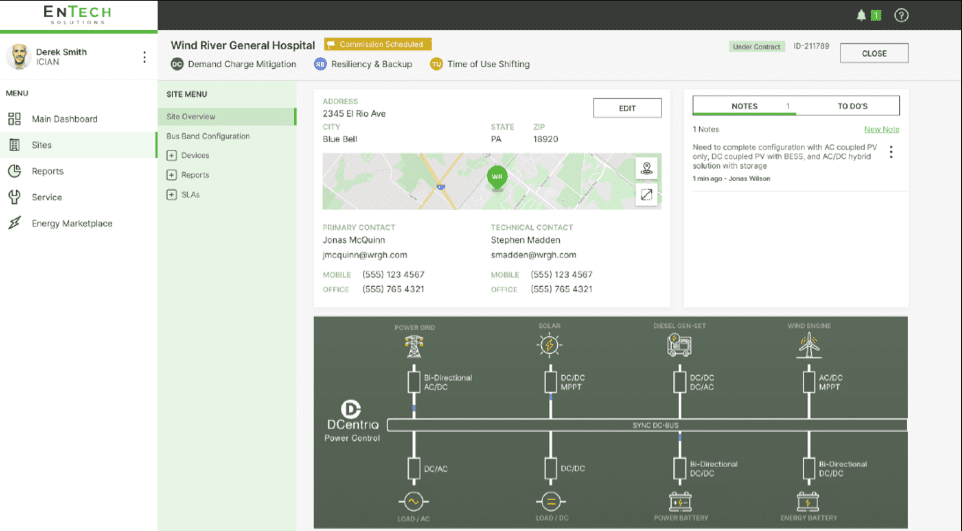EnTech Solutions, a sister company of Faith Technologies, was created to provide renewable, resilient energy solutions that enable its partners to control energy costs and reliability and minimize their environmental impact. EnTech utilizes microgrids that leverage proprietary power control hardware, energy management software, energy storage and other distributed energy resources (DERs) to consistently deliver high-value, reliable electricity. These systems are designed by taking a customer’s energy needs into consideration during planning and commissioning to ensure EnTech can provide absolute value for each system installed.
COMMENTARY
Traditionally, sources of renewable energy have been managed locally at their physical locations. When a company deployed a microgrid, technicians would need to be at its location to adjust settings or perform updates.
Microgrids are a focus of POWER’s virtual Distributed Energy Experience, scheduled for Oct. 19-22. The event moved online when the in-person Distributed Energy Conference was put on hold due to the COVID-19 pandemic. An extra day of sessions has been added for the virtual event. Register today for this important event and join the discussion around microgrids.
Performance monitoring has also been conducted locally, with identification of issues happening reactively when technicians are called in after an inefficiency or loss of power occurs to make corrections. In this case, predicting future issues and acting before they can occur is more or less a guessing game. As one would expect, attempting to scale these microgrids by expanding existing systems, or by scaling across geographies, quickly becomes resource and time intensive, and increases the complexity of performing analytics, diminishing overall ROI.

Earlier this year, determined to provide the most valuable product possible, EnTech initiated a program to greatly enhance the digital capabilities of its DCentrIQ platform. Through a highly iterative process of collecting use cases for customers, technicians and engineers, EnTech developed a comprehensive strategy to integrate digital applications into its microgrid solution. The company identified four major categories of inefficiencies or gaps posed by traditional systems which they are solving using digital applications and data analytics:
- Energy Modeling and Engineering Through a Dedicated User Interface (UI). Traditionally, energy engineers manually determined the correct size and configuration of microgrids, focusing heavily on performing calculations. Where software has been used, it has not been comprehensive, requiring engineers to piece together information. A comprehensive energy analysis application can accurately handle complex calculations automatically and display data for analysis. This ultimately enables energy engineers to focus on the customer use cases rather than data compilation, helping drive ROI through system optimization based on customer needs.
- Microgrid System and Energy Visualization. Utilizing Internet of Energy (IoE) technology, multiple internet-enabled microgrids can be monitored at once through a web or mobile application. This allows owners, technicians and other users a quick and easy way to view performance data from the edge remotely, minimizing labor requirements and time spent physically managing systems, all while greatly improving the user experience.
- Remote Systems Management. Where traditional systems need to be configured onsite, EnTech’s digitally enabled systems can be adjusted over the internet. This enables technicians to improve performance quickly, iteratively and remotely through the management of features such as time-of-use shifting, on-grid/off-grid modes, battery reserve settings and firmware patch management. An alerts platform is also able to remotely notify and dispatch technicians in the event of issues requiring onsite attention, minimizing downtime and ensuring customers can continue their operations. These features enable customers to scale their systems more efficiently, gaining more production capacity with lower costs than traditional systems.
- Data Capture and Predictive, Analytics-Based Action. Microgrids generate a large amount of data, which, until integration of advanced computing, was generally lost. Using advanced analytics, web connectivity and machine learning, EnTech can capture this data in the cloud, use software to analyze it and automatically improve system performance. For example, customer usage data can be paired with energy production and third-party weather data to determine how the environment will impact a customer’s ROI. Rather than receiving a larger than expected energy bill because cloud cover impacted solar production, causing energy to be drawn from the grid at the time of use, EnTech’s systems can automatically use data to predict production levels and store solar energy in batteries for use during periods of low output. Additionally, utilizing information on utility pricing, the system could analyze production and usage vs. cost to determine the most cost-effective time to charge batteries using the grid in the event of extended inclement weather. This ultimately maximizes customer ROI with no manual intervention, increases employee productivity and enhances the user experience.
The integration of digital connectivity can vastly improve the microgrid user experience, making it easy for customers to transition to renewable, resilient energy at scale. The use of data analytics compounds this ease, helping customers achieve fully optimized energy production and usage with minimal manual intervention.
—Dan Nordloh is senior vice president and general manager, Distributed Energy, at EnTech Solutions.










